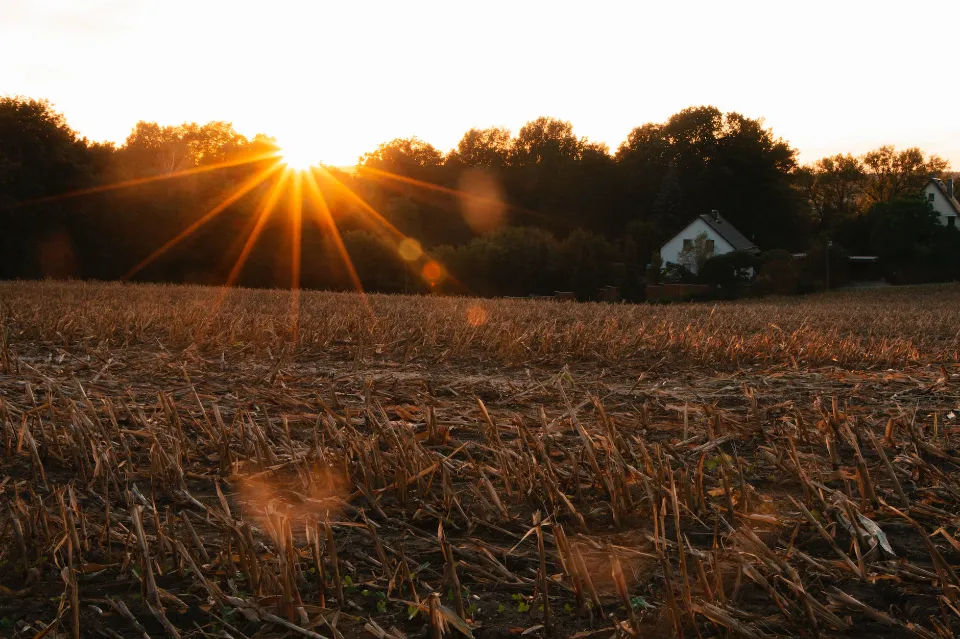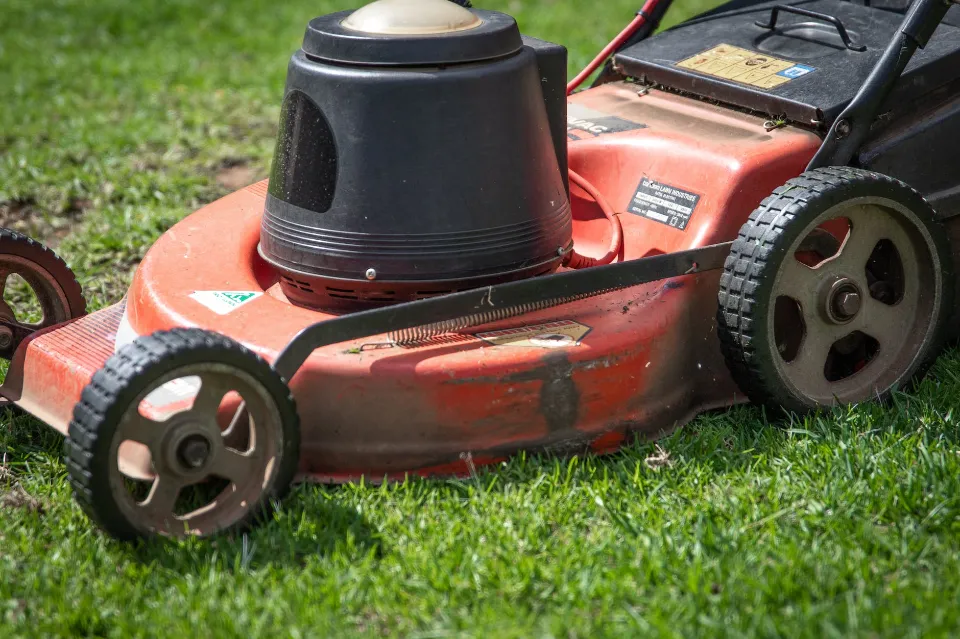Your lawn will more readily absorb nutrients and water once it has been properly aerated. The grass will grow much more colorful blades and stronger root systems.
Let extra soil or soil plugs dry where they land after you’ve finished aerating your lawn. They’ll break down in rain or crumble the next time you mow, adding beneficial soil and organic matter to your lawn surface.
When Should You Aerate?

When your lawn’s soil becomes compacted, aeration is necessary. The growth of grass roots is hampered by compacted soil. Your lawn will turn yellow, die, or you risk letting weeds take over if you don’t aerate it. Test your lawn with a screwdriver to see if the soil is so dense that aeration is required.
- The day before you test the soil, water your lawn.
- Enter the ground with a screwdriver.
- The soil DOES NOT need aeration if a screwdriver can easily sink 2 to 4 inches into it.
- Aeration is required if the soil is difficult to penetrate with a screwdriver.
- In your yard, test three to five different locations. High traffic areas may experience localized soil compaction.
The best option for your yard is a core aerator if your soil needs to be aerated. Most hardware stores rent out motorized core aerators. It is the best tool for releasing compacted soil, allowing air, water, and nutrients to reach your lawn’s root system.
Also Read: How Often Should You Apply Sulfur to Lawn – 2023 Guide
What to Do After Aeration
Let extra soil or soil plugs dry where they land after you’ve finished aerating your lawn. They’ll break down in rain or crumble the next time you mow, adding beneficial soil and organic matter to your lawn surface.
Allow Soil Plugs to Break Down Naturally
Soil plugs will be dispersed throughout your yard after using a core aerator. Although it may be tempting to clean up your yard, it is best to wait for soil plugs to dry and decompose naturally.
Mowing and regular lawn use, as well as precipitation, will gradually destroy soil plugs. This enables easy access for water and fertilizer to the holes created by core aeration as well as the mixing of air and nutrients with the soil.
Best for: All lawns. It is always recommended to give the soil plugs left behind by aeration machines time to decompose.
Overseed With New Grass
Holes that are 2 to 3 inches (5 to 7.5 cm) apart are left behind by a core aerator. The grass seed will have the ideal shelter in these holes. They allow seeds to take root and keep them protected from birds and other scavengers.
After aerating your lawn, spread grass seed over your lawn using a broadcast spreader. After that, to ensure great results, properly water and maintain your newly overseeded lawn.
Best for: lawns with thin, sparse grass or bare patches where grass has died.

Apply Pre-Emergent Weed Killer
Pre-emergent herbicide kills plants as they sprout. It will stop any grass and weed seeds from growing for up to 6 weeks after application. Keep in mind, because it stops grass seeds from growing, you can’t apply pre-emergent if you’ve overseeded in the past 4 weeks or plan to overseed within the next 6 weeks. Both grass seedlings and weeds will be killed by it.
If you don’t intend to overseed and have a lush, dense lawn, you should use a pre-emergent weed killer after aerating. Herbicide can enter the soil through the holes made by the aerator tines, where it forms a barrier that prevents weeds from sprouting and kills them. Applying your herbicides right after aeration will greatly improve their performance.
Fertilize
Any fertilizer is drawn deeply into the ground by recently aerated soil, feeding grass roots and having a significant positive effect. After aeration, use an organic fertilizer with a high nitrogen content for a healthy lawn.
For established yards, milorganite is a great fertilizer option, especially when combined with Scotts Turf Builder or another fertilizer. It delivers nitrogen over an extended period of time and will not burn your yard. If you’ve recently overseeded, use a lawn-starter fertilizer to kickstart your grass seed.
Provide Adequate Water
Following aeration, thoroughly water your lawn. Continue to thoroughly water twice weekly for 30 to 60 minutes each time. This promotes the development of grass roots in both existing grass plants and any new seeds.
Foot and vehicle traffic compact the ground, making it less permeable to water. Watering attempts will run off compacted soil, starving grass. One of the best things to do following aeration is to establish a proper watering schedule to revive failing grass.
Best for: lawns with grass that is turning yellow or brown.
Dethatching Vs. Aerating: Do One Or Both?
Similar to compacted soil, excessive thatch buildup (more than 1 inch thick) deprives the soil of water and nutrients. While a core aerator will assist in removing thatch, dethatching should be done first for the best results.
The spongy layer of thatch on top of the soil will be removed from your lawn after dethatching. This will improve the effectiveness with which your core aerator penetrates the soil. Dethatch first, followed by aeration, can revive a thin, failing lawn.
What is the Best Time of Year to Aerate?
The ideal time to aerate is generally thought to be spring. A spring aeration run enables your lawn to benefit from the recently loosened soil throughout the growing season. However, some grass responds to aeration best in the fall. The type of grass in your lawn determines when to aerate it properly.
Best Aeration Timing by Grass Type
- Warm-Season Grasses: Spring to early summer
- Cool-Season Grasses: Early fall
Warm-season grasses, such as Bermuda and St. Augustine, which can tolerate aeration in early summer (May through June), should be aerated in the spring (March through April). Plan to aerate your warm-season grass lawn in the spring because this is also when fertilization, overseeding, and other practices are most beneficial.
Cool-season grasses, such as Fescue and Ryegrass, perform better if aerated in early fall (late August through September). Cool-season grasses also respond best to dethatching, fertilizing, and overseeding in fall. Plan the project for autumn to reap the greatest benefits from cool-season grass aeration.

Conclusion: How to Treat Your Lawn After Aerating
After aeration, the best way to care for your lawn is to let the soil plugs naturally decompose, establish a regular watering schedule, fertilize with a high-nitrogen fertilizer, and either overseed your lawn with new grass or use a pre-emergent herbicide to prevent weeds from sprouting.
FAQs
Can You Walk on Lawn After Aeration?
After aerating, you are able to walk on your lawn, though you should try to avoid doing so while the new grass is still growing. You can resume using your yard normally once you are able to mow it.
What Should I Put on My Lawn After Aerating?
After aerating, it’s critical to use a fertilizer that is appropriate for the soil. What type you need depends on whether you overseed or not. A starter fertilizer is a good choice if you overseed. It shouldn’t contain weed control because that will hinder germination.
How Soon After Aeration Should I Seed?
You should overseed, fertilize, and water your lawn 48 hours after aerating. The seed, fertilizer, and water will have the best chance to get down into the holes made by the aerator if applied soon after aeration.
Should I Fertilize After Aerating?
Aerating usually works best before applying fertilizer because it promotes deeper root growth and more oxygen to the grass. If you have compact soil or clay soil, it is especially crucial to aerate before so that the fertilizer reaches deeper roots.








